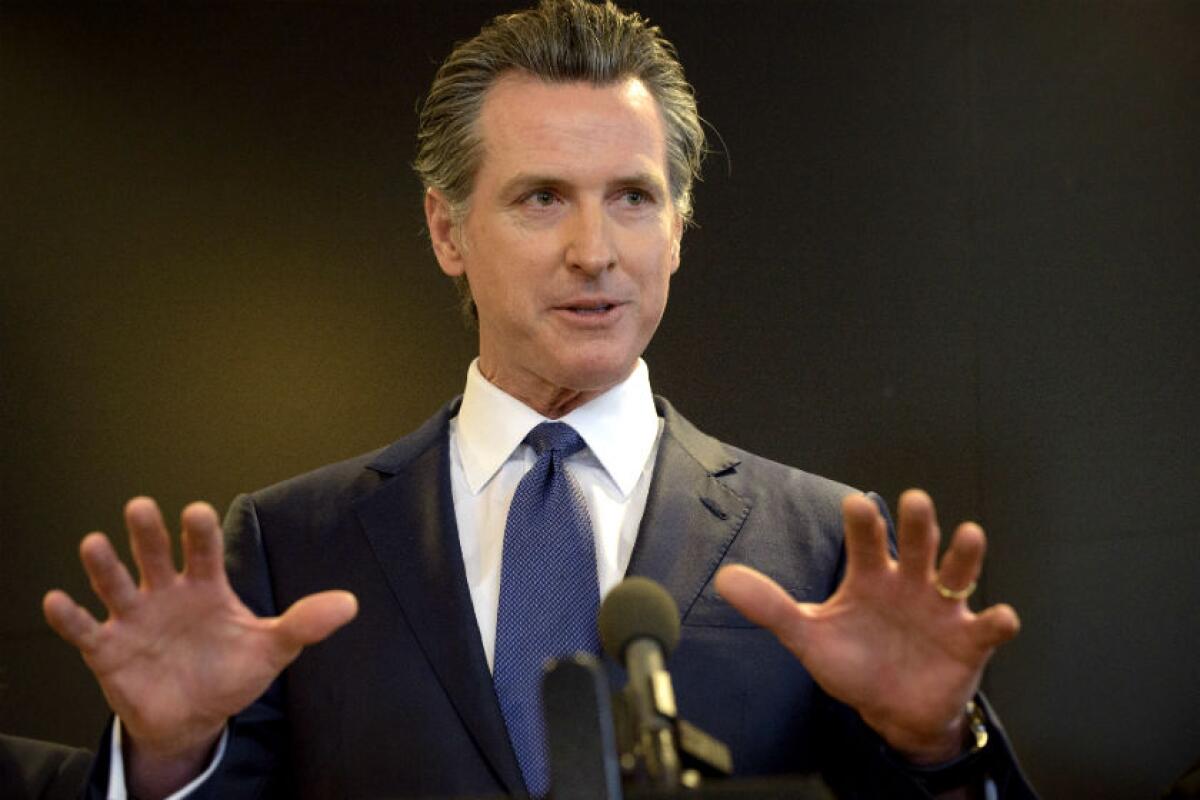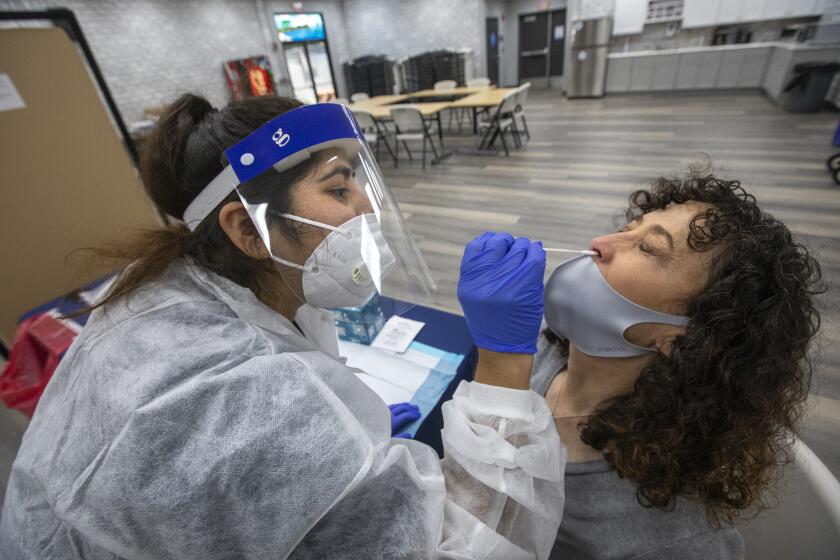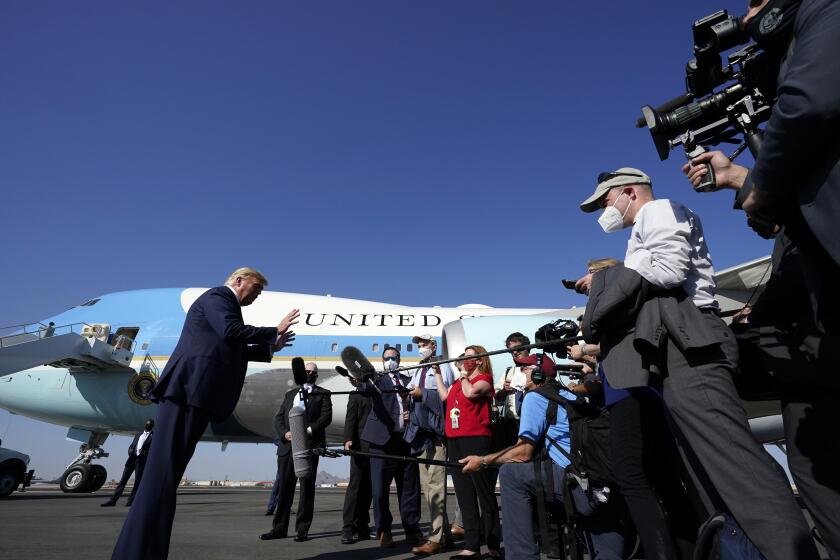As California braces for second wave of COVID-19, a statewide vaccine plan is taking shape

- Share via
Gov. Gavin Newsom on Monday announced an 11-member scientific safety review workgroup has been set up to independently review any federally approved coronavirus vaccinations, which could be available in very limited supplies sometime this calendar year.
“These experts will independently review and monitor any vaccine trials to guarantee safety, to guarantee equity and to guarantee transparency of the distribution of our vaccines,” he said, listing UCLA, UC San Diego, Stanford and UC Berkeley among panelists’ affiliations.
Drugmakers Moderna and Pfizer have been working with federal agencies to accelerate approval of two separate coronavirus vaccines still in the trial phase. Newsom said initial supplies could be ready as early as November or December but would be extremely limited at first; optimistic estimates place the number at 45 million doses nationwide.
Upon review, state officials would prioritize potential recipients, placing healthcare workers at the top of the list, followed by essential workers, seniors and others with a high risk of transmission.
While the number of daily COVID-19 deaths has fallen dramatically in California in the past few months, the state’s death toll has become the third-highest in the nation.
“Don’t anticipate or expect that you can go down to the local pharmacy any time this calendar year and likely get a vaccination,” Newsom said. “These limited doses will be for a limited number of people — we don’t anticipate mass availability until 2021.”

State officials last week submitted a vaccine plan to the Centers for Disease Control and Prevention that helped secure nearly $28.9 million in federal funding to support vaccine distribution, storage, supplies and data collection and reporting. California is one of five jurisdictions nationwide working with the CDC and Department of Defense to develop advanced planning for a vaccine.
Doses would have to be stored in cold or ultra-cold facilities — defined as below 20 degrees Celsius and below 70 degrees Celsius, respectively — and would be given as a series of two doses within a 21-day period.
The logistical complexity of storing vaccines, distributing them and ensuring people receive the required second dose will require immense data management, Newsom said. The California Immunization Registry, already handling millions of records on pediatric and influenza immunizations, is one system whose capabilities are being examined by IT experts.
Newsom assured any expansion of a statewide vaccination registry would be conducted with citizens’ privacy concerns in mind and that the state will engage in widespread outreach to ensure residents know where to go and what to do once a vaccine does become more broadly available.
“This vaccine plan will move at the speed of trust,” he said. “You have to have to have confidence in the efficacy of the vaccine [and] confidence that we’re not rushing to judgment in terms of its distribution and accessibility.”
Newsom reported Monday the state was looking ahead to a possible second wave of coronavirus infections and hospitalizations, for the first time since high rates were recorded in June and July, while other parts of the nation began to report a third wave.
“This vaccine plan will move at the speed of trust.”
— Gov. Gavin Newsom
California Department of Public Health figures show while the state’s 14-day average of COVID-19-related hospitalizations had declined 4%, the seven-day averages showed a slight uptick of .7%. The 14-day average of ICU admissions also decreased 3% but increased 5.4% when averaged in the last seven days. Newsom reported a seven-day testing positivity rate of 2.4%
As U.S. COVID-19 deaths top 220,000, Trump slams Dr. Fauci and “all these idiots” who he says were wrong on the pandemic.
In Orange County, health officials on Tuesday reported 302 new infections and two deaths, amounting to 57,373 cases and 1,412 total deaths so far. Some 168 people were being treated for COVID-19 in area hospitals, including 63 in intensive care units.
A total of 1,010,938 tests have been issued countywide, including 10,271 on Tuesday alone, while the Orange Care Health Care Agency reports a seven-day average testing positivity rate of 3.2%. The average number of new cases per 100,000 residents over a seven-day period stood at 4.6 Tuesday.
Here are the latest cumulative coronavirus case counts and COVID-19 deaths for select cities in Orange County:
- Santa Ana: 11,074 cases; 303 deaths
- Anaheim: 9,820 cases; 308 deaths
- Huntington Beach: 2,519 cases; 82 deaths
- Costa Mesa: 1,950 cases; 43 deaths
- Irvine: 1,807 cases; 13 deaths
- Newport Beach: 1,197 cases; 26 deaths
- Fountain Valley: 544 cases; 19 deaths
- Laguna Beach: 241 cases; fewer than five deaths
Here are the case counts by age group, followed by deaths:
- 0 to 17: 4,209 cases; one death
- 18 to 24: 8,655 cases; four deaths
- 25 to 34: 12,303 cases; 20 deaths
- 35 to 44: 9,142 cases; 38 deaths
- 45 to 54: 9,265 cases; 112 deaths
- 55 to 64: 6,857 cases; 199 deaths
- 65 to 74: 3,440 cases; 277 deaths
- 75 to 84: 1,930 cases; 308 deaths
- 85 and older: 1,524 cases; 453 deaths
Updated figures are posted daily at occovid19.ochealthinfo.com/coronavirus-in-oc. For information on getting tested, visit occovid19.ochealthinfo.com/covid-19-testing.
All the latest on Orange County from Orange County.
Get our free TimesOC newsletter.
You may occasionally receive promotional content from the Daily Pilot.






